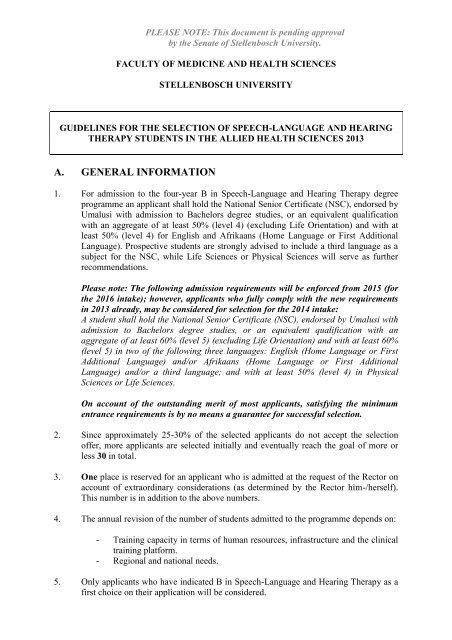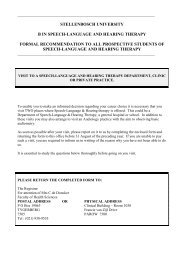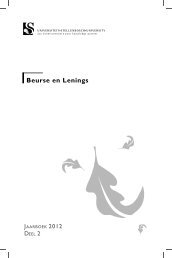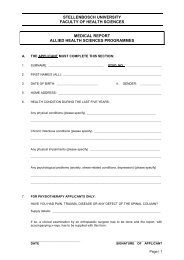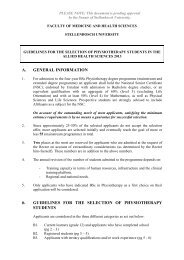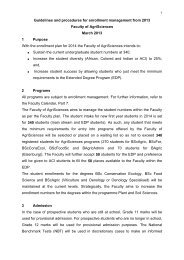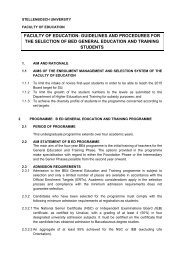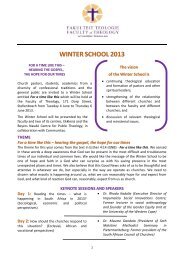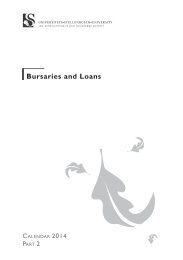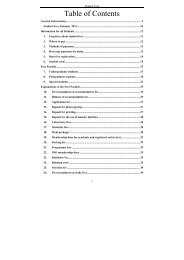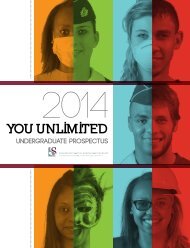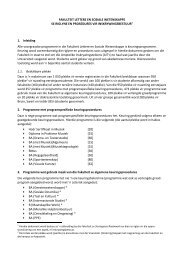FAKULTEIT GESONDHEIDSWETENSKAPPE - Matie
FAKULTEIT GESONDHEIDSWETENSKAPPE - Matie
FAKULTEIT GESONDHEIDSWETENSKAPPE - Matie
You also want an ePaper? Increase the reach of your titles
YUMPU automatically turns print PDFs into web optimized ePapers that Google loves.
PLEASE NOTE: This document is pending approval<br />
by the Senate of Stellenbosch University.<br />
FACULTY OF MEDICINE AND HEALTH SCIENCES<br />
STELLENBOSCH UNIVERSITY<br />
GUIDELINES FOR THE SELECTION OF SPEECH-LANGUAGE AND HEARING<br />
THERAPY STUDENTS IN THE ALLIED HEALTH SCIENCES 2013<br />
A. GENERAL INFORMATION<br />
1. For admission to the four-year B in Speech-Language and Hearing Therapy degree<br />
programme an applicant shall hold the National Senior Certificate (NSC), endorsed by<br />
Umalusi with admission to Bachelors degree studies, or an equivalent qualification<br />
with an aggregate of at least 50% (level 4) (excluding Life Orientation) and with at<br />
least 50% (level 4) for English and Afrikaans (Home Language or First Additional<br />
Language). Prospective students are strongly advised to include a third language as a<br />
subject for the NSC, while Life Sciences or Physical Sciences will serve as further<br />
recommendations.<br />
Please note: The following admission requirements will be enforced from 2015 (for<br />
the 2016 intake); however, applicants who fully comply with the new requirements<br />
in 2013 already, may be considered for selection for the 2014 intake:<br />
A student shall hold the National Senior Certificate (NSC), endorsed by Umalusi with<br />
admission to Bachelors degree studies, or an equivalent qualification with an<br />
aggregate of at least 60% (level 5) (excluding Life Orientation) and with at least 60%<br />
(level 5) in two of the following three languages: English (Home Language or First<br />
Additional Language) and/or Afrikaans (Home Language or First Additional<br />
Language) and/or a third language; and with at least 50% (level 4) in Physical<br />
Sciences or Life Sciences.<br />
On account of the outstanding merit of most applicants, satisfying the minimum<br />
entrance requirements is by no means a guarantee for successful selection.<br />
2. Since approximately 25-30% of the selected applicants do not accept the selection<br />
offer, more applicants are selected initially and eventually reach the goal of more or<br />
less 30 in total.<br />
3. One place is reserved for an applicant who is admitted at the request of the Rector on<br />
account of extraordinary considerations (as determined by the Rector him-/herself).<br />
This number is in addition to the above numbers.<br />
4. The annual revision of the number of students admitted to the programme depends on:<br />
- Training capacity in terms of human resources, infrastructure and the clinical<br />
training platform.<br />
- Regional and national needs.<br />
5. Only applicants who have indicated B in Speech-Language and Hearing Therapy as a<br />
first choice on their application will be considered.
B. GUIDELINES FOR THE SELECTION OF SPEECH-LANGUAGE<br />
AND HEARING THERAPY STUDENTS<br />
Applicants are considered in the three different categories as set out below.<br />
B1. Current learners (grade 12) and applicants who have completed school<br />
(pg 2 -3)<br />
B2. Registered students (pg 3 – 5)<br />
B3. Applicants with tertiary qualifications and/or work experience (pg 5)<br />
1. CURRENT LEARNERS (GRADE 12) AND APPLICANTS WHO HAVE<br />
COMPLETED SCHOOL<br />
1.1 Selection of this group takes place at the first selection opportunity during the second<br />
semester of the preceding year.<br />
1.2 Applicants within this category (+ 22 places) are selected on the basis of academic as<br />
well as non-academic merit:<br />
1.2.1 Academic merit, which constitutes 45% of the selection factor.<br />
1.2.1.1 In the case of Grade 12 learners, the average academic percentage obtained in the final<br />
Grade 11 year-end examination is used.<br />
1.2.1.2 In the case of applicants who have completed school, the average academic percentage<br />
obtained in the National Senior Certificate (NSC) Examination or equivalent is used.<br />
1.2.2 National Benchmark Tests (NBT), which comprises 30% of the selection factor.<br />
The average percentage obtained in the tests will be used.<br />
1.2.3 Non-academic merit, which constitutes 25% of the selection factor.<br />
1.2.3.1 The non-academic merit mark is calculated on the basis of the following scale.<br />
Information is gathered by means of a structured questionnaire. The accuracy of the<br />
information must be verified by the school principal. The onus rests upon the<br />
applicant, as well as the school principal, to ensure that the information is complete<br />
and correct.<br />
INFORMATION WITH REGARD TO<br />
MAXIMUM MARK<br />
* Leadership 5<br />
* Community service 4<br />
* Cultural activities 4<br />
* Sport 4<br />
* Other extraordinary achievements 4<br />
* Language proficiency 3<br />
* Association with SU (parents/sibling(s) are alumni/<br />
current students or staff) 2<br />
* Rural origin 1<br />
* Part-time or after-hours employment 1<br />
2
1.2.3.2 The score for each of the items is the maximum possible score. The marks are<br />
calculated according to specific and consistent criteria. Only achievements during the<br />
last 3 years at high school level are taken into consideration.<br />
1.2.3.3 No additions or changes may be made to the non-academic merit form once it has<br />
reached the selection office. The only exceptions being marks obtained after the form<br />
has been dispatched and only if verified by the school principal, provided that the<br />
selection office receives the form not later than the end of June of the relevant year.<br />
1.3 The selection factor is calculated by adding up the academic and non-academic merit<br />
marks, as well as the NBT average in a 45:30:25 ratio. All applicants are then ranked<br />
according to merit, which forms the basis for selection.<br />
1.4 The selection process takes place as follows:<br />
1.4.1 The top 10 applicants are selected in priority sequence according to the selection<br />
mark, irrespective of country of origin, race or any other considerations.<br />
1.4.2 Then all black, coloured and Asian applicants who qualify, will be selected until all<br />
the available places have been filled. Applicants who obtain an average percentage<br />
between 50 and 54.9% may be considered for the mainstream programme, if they<br />
passed at least 2 of the NBT tests on the proficient level.<br />
1.4.3 Qualifying foreign nationals will also be chosen and considered on merit.<br />
1.4.4 If there is still space available in the programme after all coloured, Asian and black<br />
applicants have been selected, applicants are then selected according to order of<br />
priority until all spaces have been filled.<br />
1.4.5 When all the available places are filled, approximately 30 of the remaining applicants<br />
who qualify are put on the waiting list, as follows:<br />
<br />
<br />
<br />
The order is determined by the calculated selection factor.<br />
As soon as the final National Senior Certificate marks (or equivalent) become<br />
available, these are used instead of the Grade 11 marks and the waiting list<br />
order is adjusted accordingly.<br />
Cancellations are replaced from the waiting list according to merit based on the<br />
selection factor, provided that there is place in the programme.<br />
1.4.6 Initially unsuccessful applicants who earn significantly higher marks in the National<br />
Senior Certificate examination (or equivalent) and meet the minimum admission<br />
requirements, can apply for reconsideration within 7 working days after the results<br />
have been made available. These applications will then be considered together with<br />
the applicants on the waiting list, if such a person obtains a new calculated selection<br />
factor that falls within the order of ranking on the waiting list.<br />
2. REGISTERED STUDENTS<br />
2.1 Approximately 6 of the places are filled from this group.<br />
3
2.2 The majority of these places are reserved for students of this university, as well as for<br />
students from other universities who follow suitable fields of study (preferably related<br />
to the social or natural sciences).<br />
2.3 The following registered students are collectively considered in this category:<br />
First-year and final-year Bachelor’s students (see 2.4 for exception)<br />
Honours students<br />
Final-year Master’s students<br />
Doctoral students completing their doctoral studies in the year in which they<br />
have applied<br />
No pre-determined number exists for any of the above-mentioned groupings.<br />
2.4 Registered students who follow another selection programme in Health Sciences at the<br />
SU will not be considered.<br />
2.5 Registered students who follow another selection programme in Health Sciences at<br />
another university will not be considered for selection. These students, who would like<br />
to apply for a transfer, will be considered by the programme committee.<br />
2.6 The selection process takes place as follows:<br />
This group is selected on the basis of academic performance, as well as a few other<br />
considerations (see 2.7):<br />
Academic merit<br />
The average academic performance of registered students is calculated as follows:<br />
<br />
<br />
In the case of first-year students (BSc I and other programmes), the weighted<br />
average performance of the first year is calculated.<br />
In the case of final-year students, the weighted average performance of all the<br />
years of study is calculated jointly.<br />
2.7 The following additional guidelines also apply to this category of applicants:<br />
2.7.1 Only applications from current students who will complete their degree in the relevant<br />
year, or first-year students who pass all their first-year subjects, will be considered.<br />
2.7.2 In the case of students who complete the degree in the year concerned, preference will<br />
be given to students who complete the degree in the prescribed time, and with a<br />
weighted average of at least 60% for the duration of the programme. In the case of<br />
first year students, preference will be given to students who pass all their subjects with<br />
a weighted average of at least 60%.<br />
2.7.3 In the case of post graduate students, undergraduate performance is also considered.<br />
2.7.4 Students who are selected for B in Speech-Language and Hearing Therapy I could be<br />
exempted from corresponding modules which they have passed, according to certain<br />
criteria, but all the modules from which they are not exempted must be passed in order<br />
4
for them to be promoted to Speech-Language and Hearing Therapy II the following<br />
year.<br />
2.8 Registered SU students’ applications are considered in early December, after the<br />
final results have become available. Students who do not make use of the first<br />
examination opportunity, cannot be considered.<br />
2.9 Applications for admission from students of other universities are considered in<br />
January of the following year, after their final results have been received.<br />
2.10 Students are ranged in order of priority on the basis of the preceding considerations,<br />
and this serves as point of departure for the selection process. All registered students,<br />
both undergraduate and postgraduate, compete jointly for these places. Special<br />
consideration may be given to black, Asian and coloured students who meet the<br />
minimum requirements described in 2.7.2.<br />
2.11 When all the available places are filled, qualifying applicants are placed on a waiting<br />
list according to academic merit. Cancellations are filled from the waiting list<br />
according to academic merit, provided that there is place in the programme.<br />
3. APPLICANTS WITH TERTIARY QUALIFICATIONS AND/OR WORK<br />
EXPERIENCE<br />
3.1 Selection of this group of applicants takes place at the first selection opportunity<br />
during the second semester of the preceding year.<br />
3.2 Two places at the most will be reserved for persons with tertiary qualifications and/or<br />
work experience.<br />
3.3 The selection process takes place as follows:<br />
3.3.1 Preference will be given to applicants who have already obtained a degree in the<br />
normal time and with a weighted average of 60% or more and who have included a<br />
motivational letter with the application.<br />
3.3.2 Although these applicants are selected according to academic, as well as nonacademic<br />
merit, they are not selected according to the same formula as that used for<br />
current learners. A shortlist of meritorious applicants is then compiled after the<br />
consideration of all applications within this category.<br />
3.3.3 A final selection of applicants on the shortlist will be made after a personal interview<br />
with the relevant division, including at least one member of the Selection Committee<br />
appointed in collaboration with the convenor.<br />
3.3.4 Invitation to an interview is by no means a guarantee that an applicant will be selected.<br />
5
C. SELECTION OF ASIAN, COLOURED AND BLACK<br />
APPLICANTS<br />
1. The Faculty strives to bring the ethnic profile of the student in the Speech-Language<br />
and Hearing Therapy programme in line with the population profile of the RSA during<br />
the selection of students described in categories B1 – 3, and special attention is thus<br />
given to the selection of meritorious Asian, coloured and black applicants.<br />
2. In the case of current learners, the selection factor is calculated according to the same<br />
formula as described in B1. It is taken into account that selection will not be based<br />
solely on the 45:30:25 formula, as some applicants may not have had all the<br />
opportunities for non-academic achievements.<br />
3. Black, Asian and coloured students who do not meet the minimum admission<br />
requirements may still be admitted to the programme on the basis of a good<br />
performance in the NBT and at the discretion of the Faculty Board.<br />
D. ADDITIONAL SUPPORTING DOCUMENTATION<br />
1. Medical report<br />
All applicants must submit a medical form before they are admitted so that the<br />
prospective students can be advised in a non-discriminatory manner of the suitability<br />
of the specific profession and programme by 31 July.<br />
2. Clinical visit<br />
All applicants must provide proof that they have visited at least one speech therapy<br />
department at a general hospital or at any other institution or practice where speech<br />
therapists work by 31 July.<br />
It is recommended that you familiarise yourself with the questions on the form before<br />
going on your visit.<br />
E. TAKING THE NATIONAL BENCHMARK TESTS (NBT)<br />
1. All current learners or applicants who have completed school (B1), who apply for<br />
admission to B in Speech-Language and Hearing Therapy, irrespective of the<br />
percentage or total they obtained in the Grade 11 or 12 examinations, must take the<br />
NBT. The average percentage of these tests counts toward 30% of the selection<br />
factor.<br />
2. The tests will be conducted countrywide at various centres.<br />
3. Prospective Speech-Language and Hearing Therapy students must write the NBT<br />
before the closing date which is determined annually (see www.maties.com) by<br />
6
egistering (at least 3 weeks before the test date) at www.nbt.ac.za to secure a place<br />
at the relevant venue.<br />
4. Prospective students must write all tests on the same day.<br />
5. If a student makes use of more than one opportunity to write the NBT during the<br />
same year, only the results of the first test opportunity will be considered for<br />
selection purposes.<br />
6. Registered university students (B2) and applicants with tertiary qualifications and/or<br />
work experience (B3) are exempted from this requirement.<br />
F. FOREIGN NATIONALS<br />
Applications from foreign nationals will be considered on merit.<br />
G. PROCEDURES TO BE FOLLOWED FOR THE SELECTION<br />
PROCESS<br />
1. APPLICATION FORMS<br />
1.1 Applicants can apply electronically at www.maties.com<br />
1.2 The closing date for submitting applications, including the non-academic merit<br />
questionnaire, for consideration during the initial selection process, is 31 May of the<br />
year that precedes registration.<br />
1.3 The medical report and clinical visitation form must reach the selection offices by no<br />
later than 31 July.<br />
2. PROCESSING OF APPLICATIONS<br />
2.1 A complete database of each applicant is compiled based on the information captured<br />
by the applicant on the online application form. At the same time, the current learners’<br />
or applicants who have completed schools’ (B1) marks are processed electronically.<br />
2.2 The questionnaires on non-academic merit are checked and the marks are calculated as<br />
indicated in B.1.2.3. The marks are also captured and, together with the school marks,<br />
as well as the average of the NBT marks, are processed on computer in order to<br />
determine the final selection factor. (The selection factor is used to determine an<br />
applicant’s position on the merit list).<br />
2.3 The academic records of registered students (B2) as well as those of graduates (B3),<br />
are processed by hand and an average percentage is calculated. These students are then<br />
considered on the basis of academic performance, although non-academic merit may<br />
also be taken into consideration in the cases of graduates (B3).<br />
2.4 It is expected of applicants to provide an undertaking that all information provided is<br />
accurate. In the event that it should be discovered that a selected applicant has<br />
7
provided false information or has withheld information, he/she might forfeit their<br />
selection.<br />
3. SELECTION OPPORTUNITIES<br />
3.1 The first selection takes place during the second semester of the previous year. On this<br />
occasion current learners and applicants who have completed school (B1), as well as<br />
applicants with post-school experience and/or post-school qualifications (B3) are<br />
considered. The selection of the latter applicants (who are put on a short list) is only<br />
finalised after interviews with the members of the Selection Committee (see B3.3.3<br />
and B3.3.4).<br />
3.2 The applications of registered students (B2) are only considered after their final<br />
university results have become available (in December in the case of SU students, or<br />
in January in the case of students from other universities).<br />
3.3 Scimathus students are considered in January in the same category as applicants who<br />
have completed school (on the basis of their new selection factor).<br />
3.4 Further selection from the waiting list takes place continuously, depending on<br />
cancellations received and available places in the programme.<br />
3.5 Selection is finalised two weeks after the commencement of the first semester classes<br />
for Speech-Language and Hearing Therapy I.<br />
4. SENDING OUT SELECTION LETTERS<br />
4.1 After the selection meetings, applicants are informed in wiring of the selection results.<br />
4.2 Selected applicants must respond within 4 weeks from mailing the selection letters,<br />
stating whether or not they accept the offer.<br />
4.3 If they accept the selection offer, the prescribed selection deposit is due. The amount<br />
will be to the student’s credit. Applicants who accept their selection offer, pay the<br />
prescribed selection deposit and afterwards cancel their selection of their own accord,<br />
will not be refunded their selection deposit.<br />
4.4 The places of applicants who do not respond to the offer and who cannot be reached<br />
administratively, will be cancelled.<br />
5. APPLICANTS WHO NO LONGER MEET THE ADMISSION<br />
REQUIREMENTS AFTER THE FINAL NATIONAL SENIOR CERTIFICATE<br />
RESULTS HAVE BECOME AVAILABLE<br />
5.1 Applicants who obtained provisional acceptance during the first selection round and<br />
who do not meet the minimum requirements with their final matric results, will forfeit<br />
their selection and the selection deposit will be refunded.<br />
5.2 The applications of black, Asian and coloured applicants who forfeit their selection<br />
can be reconsidered at the discretion of the Faculty Board on condition that<br />
satisfactory results were obtained in the NBT.<br />
8
H. COMPOSITION OF THE SELECTION COMMITTEE<br />
The Selection Committee comprises the following members:<br />
<br />
<br />
<br />
<br />
<br />
<br />
<br />
<br />
<br />
The Executive Head: Interdisciplinary Health Sciences (Chairperson)<br />
The Dean, Faculty of Medicine and Health Sciences<br />
The Deputy Dean (Education), Faculty of Medicine and Health Sciences<br />
The Deputy Dean (Community Service and Interaction), Faculty of Medicine<br />
and Health Sciences<br />
The Head of Division: Occupational Therapy<br />
The Head of Division: Speech-Language and Hearing Therapy<br />
The Head of Division: Human Nutrition<br />
The Head of Division: Physiotherapy<br />
One member of the MB,ChB Selection Committee, appointed by this<br />
committee.<br />
25 March 2013<br />
9


